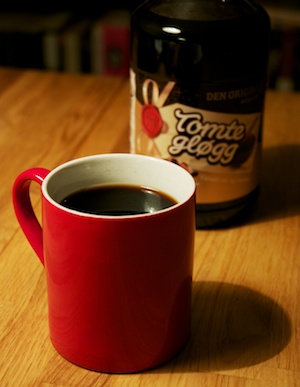

In the last week or so before Christmas, it is not uncommon for shops to have someone handing out cups of the non-alcoholic version of gløgg to Christmas shoppers (in Norway it's illegal to give away alchohol for free to the general public). The version with red wine is more commonly used at pre-christmas parties, either at specific gløgg-parties, or as a welcome drink at a party. Incidentally, I've been appointed second gløgg-assistant at the julebord I'm attending this week.
I tried reading the list of ingredients of the bottle of gløgg i bought today, but the spices are hidden behind the unhelpful label "aroma", so I'm not entirely sure what it consists of. Still, from the taste I'm guessing clove buds, cinnamon, cardamom, ginger and maybe others. As these spices, as well as sugar, make up most of the interesting ingredients of gløgg, it is pretty much the same as mulled wine, except for some reason it has become common in Norway to sell it as a syrup rather than dry spices.
I've tried a couple of times to make mulled wine by heating wine and adding what I imagined to be the appropriate amounts of the previously mentioned spices, but I never got the hang of it. However, in the UK you can easily find pre-made packages (essentially a large tea bag with spices), containing spices in the proper amounts and proportions for mulling a bottle of wine, and I must say I actually prefer those to the Norwegian gløgg. I always feel gløgg has a slightly artificial taste, and I suppose they must do something unpleasant to the syrup, as you can keep even an opened bottle for quite a long time without any observable change.
Note to Camilla: remind me to bring home a bunch of those mulled wine packages.
-Tor Nordam